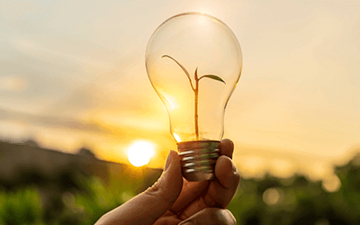Water is the world’s most valuable resource. It sustains life, drives
agriculture and powers industry. Yet decades of industrial pollution, overuse
and outdated systems have depleted freshwater supplies faster than nature can
replenish them.
Agriculture is the biggest culprit, consuming around 70
percent
of the world’s freshwater, often inefficiently. Leaky irrigation systems,
nutrient runoff and poor water management waste billions of liters each year.
Meanwhile, food producers are being pushed to feed a growing population with
fewer resources — all while navigating the impacts of climate change. According
to CDP, water risk in global supply
chains
could cost companies up to $77 billion.
The world urgently needs smarter, cleaner ways to use water — and
Chile-based water technology company Kran
Nanobubble believes the answer lies in
something undetectable to the human eye: Nanobubbles.
Measuring one-billionth of a meter in size, nanometric gas bubbles hold
extraordinary potential for improving water efficiency across multiple sectors;
when filled with gases such as oxygen, CO₂ or ozone, they can be injected into
water to enhance its natural properties.
Unlike regular bubbles that rise and burst quickly, nanobubbles stay suspended
in water for much longer. This allows them to release gas more slowly and evenly
— which leads to better oxygen distribution, improved water quality and more
efficient support for biological and chemical processes including plant growth,
fish health or cleaning operations.
Kran’s nanobubble technology enables businesses to produce more with less water;
the system can be integrated directly into existing equipment and processes —
making it an easy, plug-in solution for agriculture, aquaculture, food
production and industrial water treatment.
“Our solutions are designed to address critical challenges in industrial
processes involving liquids — such as excessive water consumption, intensive
energy use, high chemical usage and low efficiency in industrial operations,”
Martin
Castro,
Kran’s Commercial Director, explained to Sustainable Brands® (SB). “Kran
Nanobubble Systems are used at different stages of the production process. They
are integrated into existing equipment, improving process efficiency and adding
value to the final product.”
Kran was founded in 2017 in Puerto Varas, Chile, by Jaime De la Cruz
González
— an aquaculture veteran with over 35 years’ experience in the industry. Having
seen the environmental toll of industrial growth firsthand, he set out to find a
solution that could support both economic progress and environmental care.
A trip to Japan introduced him to nanobubble technology; inspired by its
potential, he committed to exploring and advancing the technology, and Kran was
born.
Kran builds its nanobubble generators in-house, using high-quality stainless
steel to ensure long-term durability — even in harsh environments such as
open-sea
aquaculture.
The system’s easy, drop-in nature eliminates the need for expensive
infrastructure overhauls.
“Our equipment can be added without major modifications, making adoption
straightforward,” Castro said. “That said, designing an effective solution still
requires precise engineering — from selecting the right gas to determining the
optimal dosage — to ensure the best possible results.”
Each system is carefully calibrated to deliver the right type and amount of gas
for a specific application. That precision is what enables nanobubbles to raise
oxygen levels, reduce the need for chemicals and boost overall performance —
whether that’s growing stronger crops, improving fish health, or cleaning food
products more safely.
Conventional methods for improving water quality often rely on high energy use,
intensive chemical treatments or costly filtration systems. Kran offers a
cleaner, more efficient alternative that reduces waste while enhancing
performance. In agriculture, its systems have achieved water savings of over 50
percent
in green areas by improving irrigation efficiency and nutrient uptake. In
wastewater treatment, clients have reported a 25.6
percent increase in organic solids removal and a 14.3 percent
reduction
in chemical oxygen demand.
“Our technology enhances water efficiency in different processes, improving
operational performance while reducing resource consumption,” Castro said. “By
increasing oxygen levels and improving water quality, nanobubbles create
healthier conditions for crop and fish growth — decreasing the need for chemical
additives and boosting productivity.”
As he explained, the effervescent technology is particularly effective in
industries where water is used intensively, and where gases such as oxygen play a
key role. In
aquaculture,
Kran’s nanobubbles increase dissolved oxygen more efficiently than traditional
aeration systems — improving fish health and feed conversion and reducing
disease risk. In agriculture, it boosts nutrient absorption and soil aeration —
supporting stronger crops with less irrigation and fewer inputs. And in the food
industry, nanobubbles enhance cleaning while reducing chemical use — all without
compromising microbiological safety.
Kran’s technology is being adopted across key global markets including
Spain, Mexico, Brazil, Argentina and its home base of Chile. The
company has already partnered with agricultural producers, aquaculture
operations and food manufacturers looking to optimize resource use along with
production.
One of Kran’s partners, Coca-Cola
LATAM, has
deployed nanobubble systems in wastewater treatment plants across Chile, Brazil and Mexico.
“Kran Nanobubbles’ technologies are helping Coca-Cola LATAM bottlers to improve
the performance of their wastewater treatment plants,” Alfeu Follador
Jr.
— Coca-Cola’s Director of New Supply Chain Technologies, LATAM OU — told SB.
“Besides the excellent results on plant performance, Kran’s technology is also
enabling a reduction in electricity consumption ranging from 25 percent to 40
percent in the aerobic stage of the process.”
Follador credits Kran’s technical depth and collaborative mindset for the
success of the partnership, which began through the 100+ Accelerator
program — a startup-scaling initiative backed
by AB InBev, Coca-Cola and other major FMCG players.
As an emerging technology, nanobubbles are still met with some skepticism. Not
all companies claiming to produce nanobubbles can scientifically validate their
results, a problem that risks undermining trust in the entire sector and
“discrediting the whole technology,” Castro said.
“We focus on proper engineering, validation and long-term results. Some of our
equipment has been running in harsh sea conditions for over four years and
remains fully operational.”
By prioritizing transparency and rigorous testing, Kran is helping to build
credibility in the nanobubble space — proving that these nearly invisible
bubbles can deliver meaningful, measurable outcomes in real-world settings.
In 2024, Kran won the first Siemens Water Innovation
Challenge
from Congreso Acades — an association that
brings together over 80 companies committed to developing non-conventional
sources and technologies to secure water for Chile — and was recently named a
Top
Innovator
by the World Economic Forum’s UpLink initiative.
“These awards show how the combination of our tailored development model and
nanobubble technology can drive real change — reducing energy use, conserving
water, cutting chemical inputs and boosting productivity,” Castro said, proudly.
“At its core, our mission is about learning to produce more with less and making
that possible at scale.”
In 2025, Kran is working to grow its manufacturing capacity and establish a US
presence — the next steps on its mission to revolutionize global industrial
water use.



